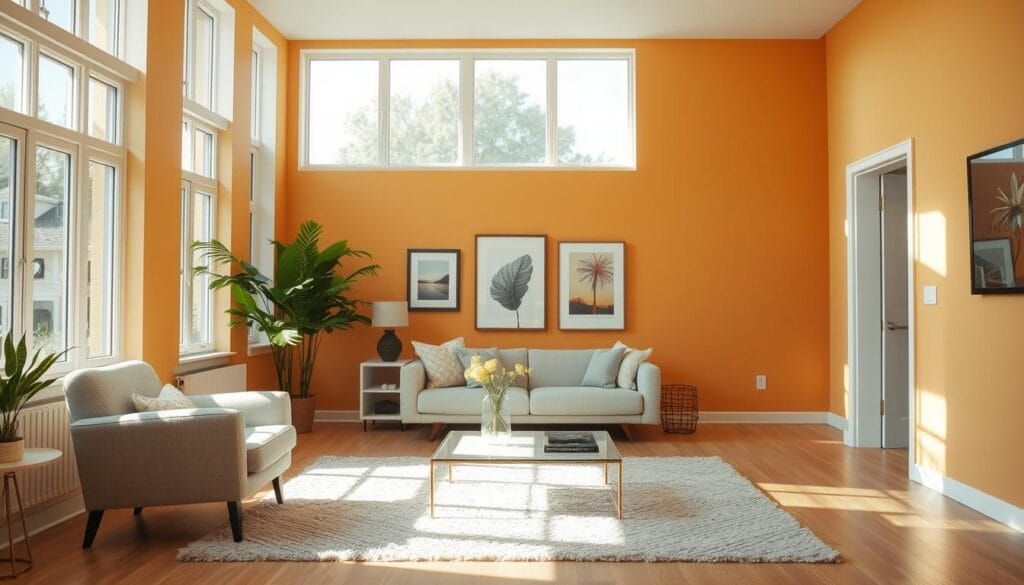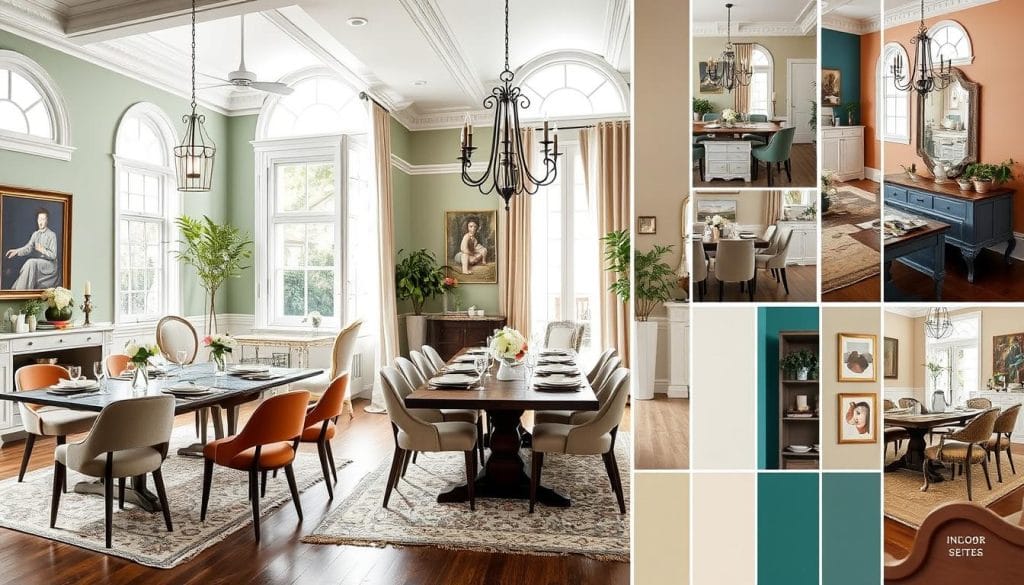Imagine walking into a room that’s looked the same for years. The walls are faded and the paint is chipping. Everything feels dull. But then, you grab a brush and some colorful paint. Suddenly, you’re on a creative adventure! Paint is more than a makeover tool; it’s a journey of transformation. It brings life to a tired living room or makes a bedroom cozier.
A fresh paint job can boost a home’s value by up to 5%. With just a bit of effort, not only can we make our space look better, but we can also increase its worth. Imagine selling your home 10% faster just by choosing the right colors! Today, we’ll explore how paint can transform rooms. We’ll look at colors that inspire you and techniques that make your walls impressive.
So, grab your favorite drink. Let’s see how simple paint makeovers can lead to beautiful changes and a fresh, new atmosphere!
The Transformative Power of Paint
Paint can change living spaces in big ways. It’s key for refreshing a dull room or redoing your home’s look. Paint can touch our feelings, shape moods, and change how we see space.
Choosing the best colors is more than beauty; it’s about paint’s role in home design.
Why Paint Matters in Home Design
Paint shapes how we feel about our homes. Light colors can make tight spaces seem bigger. Dark colors add a cozy feel to larger rooms.
A new paint job boosts your home’s look, making it sell quicker and possibly for more money. Fresh paint might up your home’s value by as much as 10%! Homes with new paint grab 50% more attention from buyers. Paint can turn any house into a stunning home.
Psychology of Color Choices
The psychology behind color choices helps create welcoming spaces. Colors can make us feel relaxed or energized. Blues and greens offer peace, while reds and yellows bring energy! Around 85% of homebuyers think a lot about color.
It’s crucial to pick colors that make us feel good. Looking for more color advice for your home? Find great tips at DIY projects to transform your home. Picking colors that fit us can make our homes more comfortable and liveable.
| Color | Effect on Mood | Recommended Room |
|---|---|---|
| Soft Blues | Calming and peaceful | Bedrooms |
| Warm Yellows | Inviting and cheerful | Living Rooms |
| Rich Reds | Intimate and stimulating | Dens |
| Earthy Greens | Refreshing and balanced | Kitchens |
Choosing the Right Paint Finish
Finding the perfect paint finish can really change the feel of your room. It is key for the room’s look and how long the paint lasts. With many choices, learning about overview of different finishes lets you pick what’s best for your area.
Overview of Different Finishes
We often see five main kinds of paint finishes:
- Matte: Good at hiding imperfections but not very strong.
- Eggshell: A bit shiny, so it’s easier to clean than matte.
- Satin: Has a gentle shine and is good for busy rooms.
- Semi-gloss: Shiny and tough, perfect for kitchens and baths.
- Gloss: Reflects light well and is easy to clean but shows flaws.
How Finish Affects Aesthetic and Durability
Choosing the right finish affects more than just the wall’s look. It also determines how finish affects aesthetic and durability. For example, glossy finishes are best for wet places. Matte finishes suit areas with less foot traffic. Thinking about this is a smart tip for changing your space affordably.
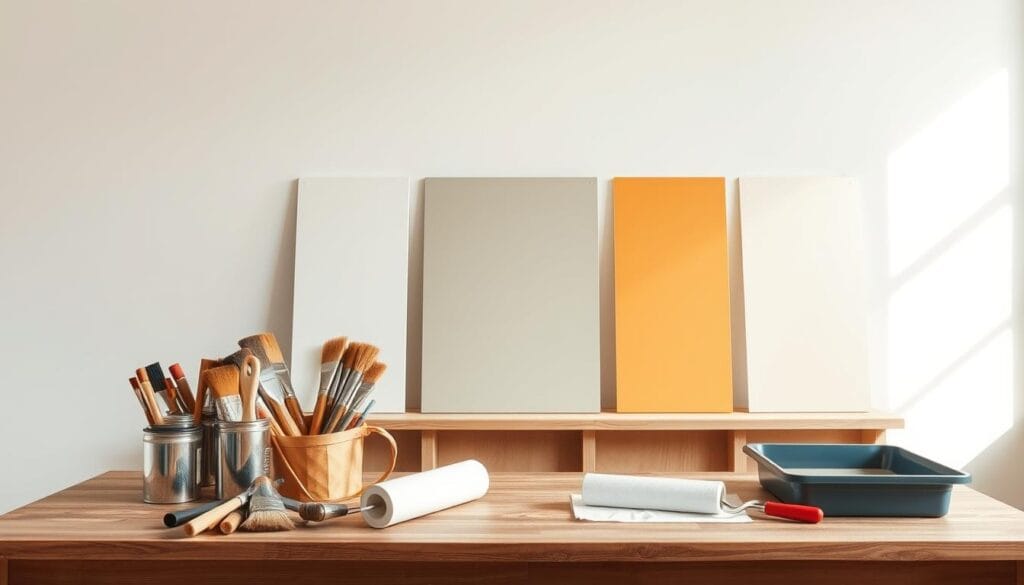
Color Schemes That Revitalize Spaces
Colors are key in changing how our spaces feel, and this year, new ideas are everywhere. The top color trends for 2023 favor earthy and warm neutrals, making any room cozy. Favorites include warm taupe, rich beige, and soft caramel, along with clay and terracotta.
Muted olive greens join these colors. They bring us closer to nature and fill our homes with calm.
Popular Color Trends for 2023
The color scene for 2023 has moved on from stark whites and cool grays. Darker shades like charcoal gray, midnight blue, and forest green bring elegance. These colors are perfect for creating cozy spaces in bedrooms and living areas.
For a splash of energy, mustard yellow and burnt orange add excitement. They make our homes lively.
Creating a Harmonious Palette
To refresh interiors with paint, choosing a balanced palette is crucial. Mixing earthy neutrals with bold accents creates engaging spaces. For example, matching warm tones with deep blues or dark wood adds layers.
Soft pastels, like dusty rose and powder blue, bring calmness. They blend well in a coordinated color scheme.
| Color Family | Examples | Best Uses |
|---|---|---|
| Earthy Neutrals | Warm taupe, Terracotta, Muted olive green | Living rooms, Kitchens |
| Deep Hues | Charcoal gray, Midnight blue, Deep aubergine | Bedrooms, Dining areas |
| Vibrant Accents | Mustard yellow, Burnt orange, Cobalt blue | Accent walls, Decorative items |
| Soft Pastels | Dusty rose, Soft lavender, Pale peach | Bathrooms, Bedrooms |
With these tips, mixing colors can make spaces not just beautiful but also welcoming. Following the 2023 trends and choosing a harmonious palette can transform your home!
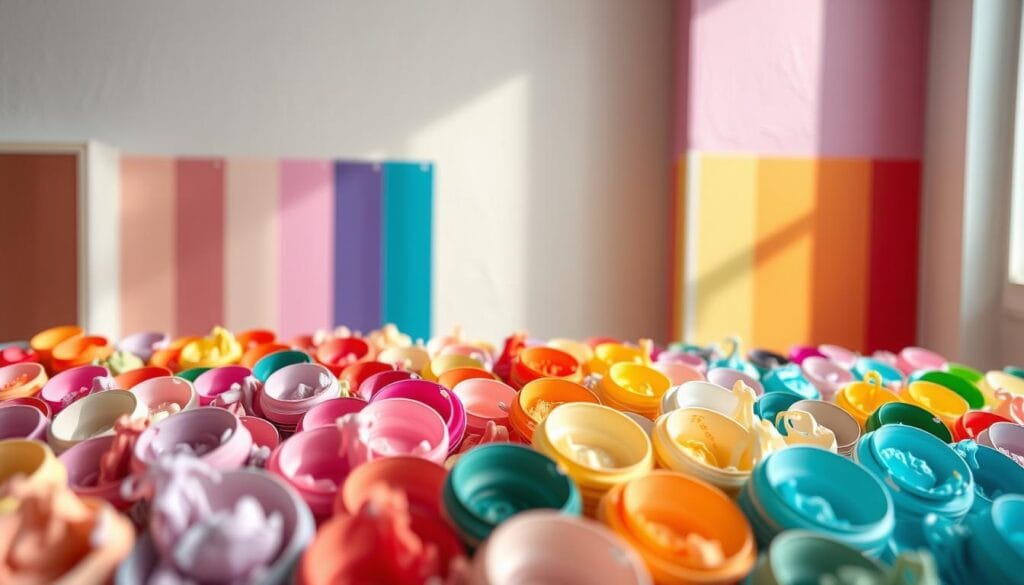
Preparing Your Space for Painting
Getting ready to paint is key to doing a great job! Start by gathering all the tools and supplies you need. This prepares your space and makes the painting easier and better. Now, let’s look at what you need to start and how to clean up easily afterwards.
Essential Tools and Supplies
First off, here are the must-haves:
- Quality brushes and rollers for a smooth application
- Painter’s tape to protect edges and create neat lines
- Drop cloths to shield your floors and furnishings
- Paint trays for easy access to your paint
- Putty knife for filling holes and preparing walls
- Sandpaper for smoothing surfaces
Having these key tools and supplies will make your painting task much simpler. It will also make learning painting tricks more fun!
Steps for an Effective Clean-Up
After you’re done painting, cleaning up is crucial. Let’s go over some simple clean-up steps:
- Wash brushes and rollers with soap and water right away to prevent paint from drying.
- Dispose of any debris, including empty paint cans and tape.
- Wipe down surfaces to remove any splatters or spills.
- Check for areas where paint might have dripped and clean them promptly.
- Store leftover paint properly for future touch-ups.
By following these clean-up steps, you keep your space tidy. This makes starting your next project much easier. Enjoy your painting!
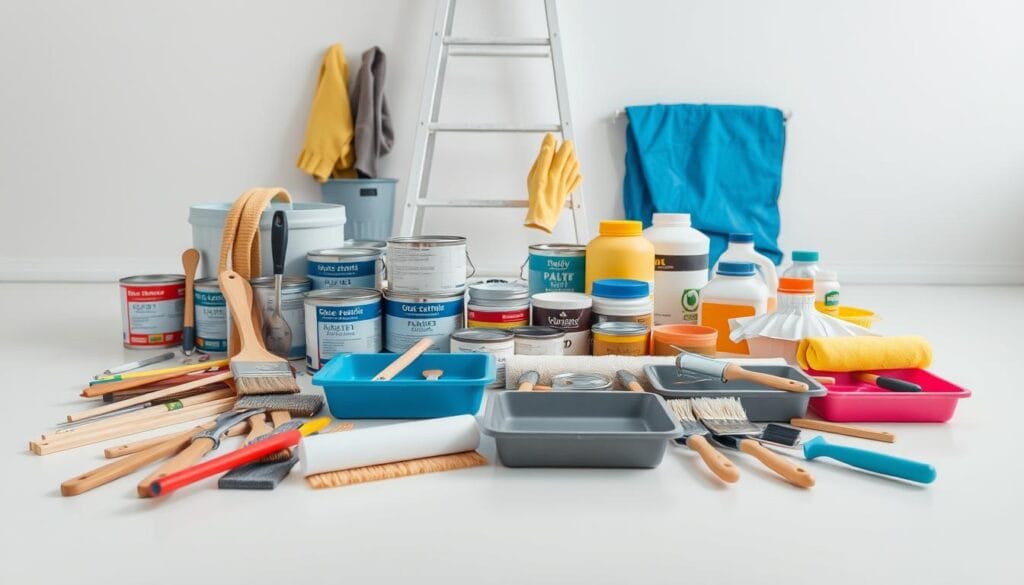
Techniques for a Flawless Application
When you decide to paint your walls, how you apply paint is crucial for a smooth outcome. Good tools can make the job faster and improve your finish. Let’s look at the differences between using a brush or a roller and talk about tips for getting smooth coats.
Brush vs. Roller: Which to Use?
The choice between a brush and a roller depends on what you’re painting. Brushes are great for detail work, like edges and corners. Rollers are better for big areas because they work fast and give a consistent look. Using top-quality brushes and rollers can cut down work time by 30% and still make your project look amazing.
Tips for Smooth, Even Coats
To paint like a pro, you need to know a few tricks. Here are key tips to get smooth, even coats:
- Thin layers of paint work best. Thick layers may drip or streak.
- Painter’s tape gives cleaner edges, cutting down on extra work by 50%.
- The “W” technique with a roller can make paint go further, saving 10-15%.
- Stir your paint well to avoid uneven colors, which happens in 20% of jobs.
- Adding a paint extender helps remove brush and roller marks, improving the look by 40%.
Choosing the right method and tools can transform your space beautifully, making it shine for years.
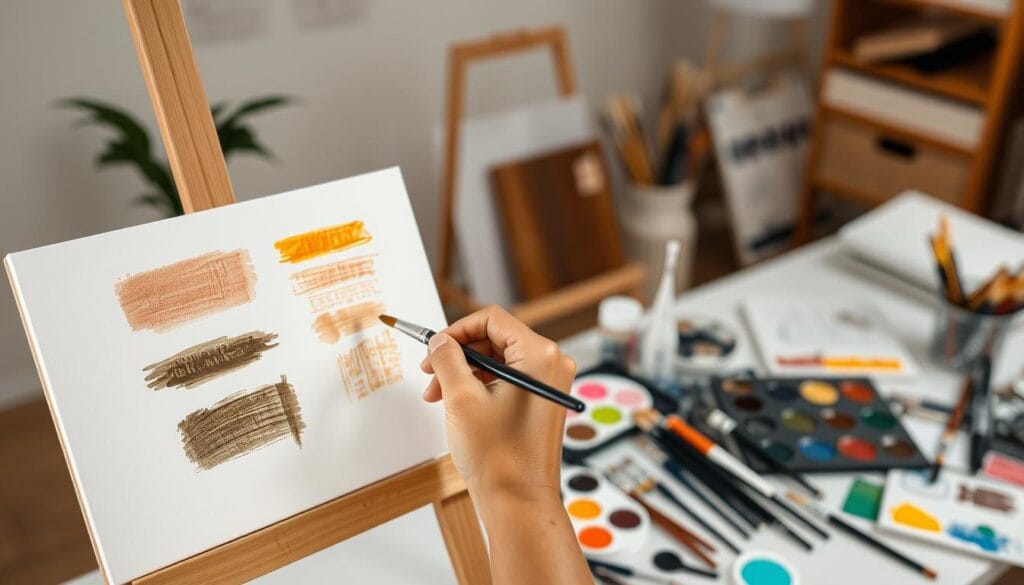
| Technique | Benefits | Recommended Tool |
|---|---|---|
| Painter’s Tape | Cleaner edges, 50% fewer touch-ups | Tape |
| W Technique | Improved coverage, reduced paint usage | Roller |
| Proper Mixing | Prevents inconsistencies, uniform color | Stir Stick |
| Paint Extender | Minimized marks, enhanced finish | Additive |
| Quality Tools | Time-saving, smoother finish | Brush or Roller |
Accent Walls: A Statement Piece
Accent walls make it easy to spruce up your living areas with paint. Picking one wall as the main attraction allows us to add style and personality to any room. Whether going bold or choosing detailed designs, the perfect accent wall can change a room’s feel. Look into best practices for creating accent walls, like considering the room’s light and decor. This helps achieve a balanced look that enhances your space.
Best Practices for Creating an Accent Wall
To effectively use paint in transforming rooms, start with some best practices. First, choose a wall that naturally attracts attention. Then pick a color that matches your design style. Light plays a key role, so choose well-lit spots for more impact. Consider using various materials like textured wallpaper or shiplap for added interest. Remember, keeping it simple is often best, so don’t overload the area with decor.
Popular Accent Wall Ideas
Many accent wall ideas are out there to match your home perfectly. Dark blue creates a refined look, while white makes spaces feel open and light. Mustard yellow adds cozy warmth, perfect for dining areas. Opt for brick or stone for a rustic touch, ideal for texture. Tile accents are stylish yet tough. With 20 dining room accent wall types available, you’re sure to find one you love!
Paint for Special Effects
Want to add some unique flair to your space? Giving your rooms a paint makeover is a great way to show off your creative side. Using textures and patterns can make ordinary walls look fascinating. No matter your style, there are exciting ideas to make your space truly your own!
Techniques for Textures and Patterns
There are many techniques to add textures and patterns with paint. Sponging creates a soft, textured appearance that brings depth to your walls. Rag rolling gives off a warm, bohemian feel. And adding a metallic sheen can introduce a touch of glam. It’s smart to try these techniques on a small spot first to see if it fits your vision.
Using Stencils for Unique Designs
Using stencils is a hands-on way to bring unique designs to your space. Stencils make it easy to apply detailed patterns, even for beginners. You could stencil a geometric pattern on an accent wall or add floral motifs around your living room. The possibilities are endless, allowing your walls to showcase your personal style!
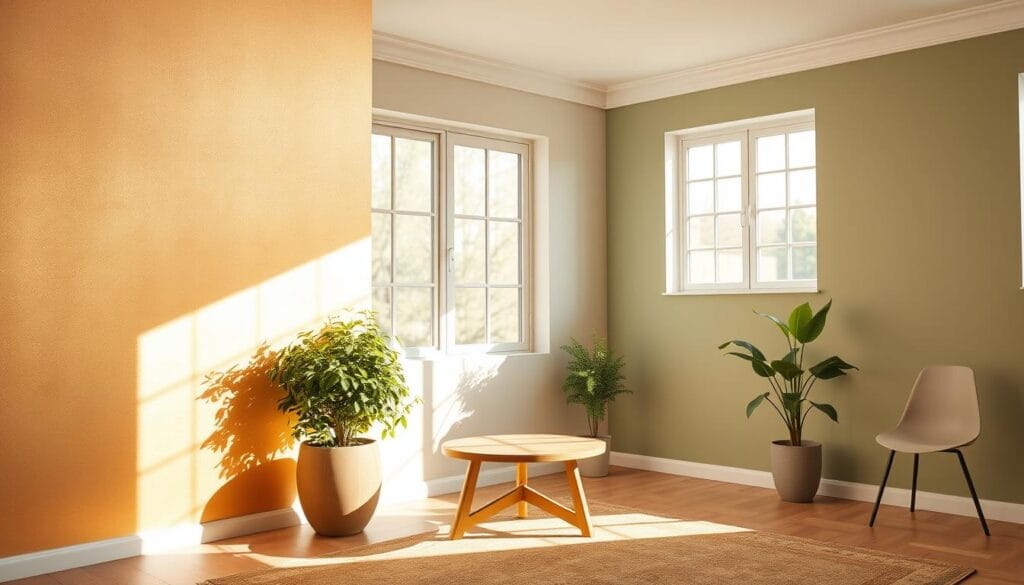
Maintenance Tips for Painted Surfaces
After a successful makeover, keeping our painted surfaces fresh and vibrant is key. Regular care helps extend the paint’s life. Here are insights on cleaning, protecting walls, and when to repaint.
How to Clean and Protect Painted Walls
To maintain your painted walls, use a gentle method. Use a soft sponge or cloth with mild soapy water. This method effectively removes dirt and stains without harming the paint. For stubborn spots, scrub lightly but avoid removing the paint.
High-traffic areas may need more attention, especially with kids or pets. Regular checks help. Keeping the paint fresh through proper cleaning is crucial. A routine cleaning schedule can set you up for success!
When to Repaint and Touch Up
Knowing when to repaint is key to keeping spaces beautiful. Exterior paint in sunny areas like Denver lasts 5-10 years. Interior paint can last over a decade with care. Light colors last longer because they reflect sunlight, reducing UV damage. Plan to repaint every 5-10 years to boost curb appeal and home value.
Look out for fading or peeling paint as signs to touch up! Using high-quality paint and sealants for your climate can help extend paint life.
For more home tips, check out this article! Follow these steps and pay attention to detail to keep your painted surfaces looking great. Your home will shine for many more years!
Eco-friendly Paint Options
It’s key now more than ever to pick eco-friendly paint choices, understanding our planet impact. Using low-VOC and natural paints makes our homes look good and keeps indoors healthier. As demand for green choices grows, many brands have begun leading in making eco-friendly paints. These products look great and do good for our environment.
Benefits of Low-VOC and Natural Paints
Low-VOC and natural paints hold great benefits. They have 0-50 grams per liter of VOCs, far less than traditional paints. By choosing low-VOC paints, we can better indoor air, cutting down harmful emissions significantly. A survey noticed that 75% of homeowners think about the environmental impact during renovations. This shows more people are picking green options now.
Brands Leading the Eco-friendly Movement
Many brands are stepping up in the eco-friendly paint sector. Benjamin Moore and Sherwin-Williams are leading with sustainable, high-quality products. Also, 60% of shoppers are ready to spend more on sustainable items. The eco-friendly paint market is expected to grow by 4.5% each year from 2021 to 2028. It shows that eco-friendly paints are more than just a trend; they’re part of moving towards a greener future.
DIY vs. Professional Painting
When we think about painting, we often weigh DIY against professional painting. Each has its benefits, but understanding the pros and cons of DIY painting is crucial. This knowledge can help you decide whether to hire a pro or do it yourself.
Pros and Cons of DIY Painting
DIY painting can be rewarding, saving you money and giving a sense of pride. But, it has challenges too. Consider these points:
- Pros: Lower labor costs, personal design control, and working at your own pace.
- Cons: It’s time-consuming, skills might be lacking for a pro finish, and material costs can be high due to mistakes.
DIYers often take 50% longer to finish projects than professionals. If your project is big or complex, think about time carefully.
When to Hire a Professional
Professional painters offer skills and quick work. Here’s when to hire one:
- For big projects, like painting a whole house or a large area.
- When walls need repairs, pros can fix them well.
- If you need the job done fast, pros work quicker than DIY.
Pros ensure a high-quality and durable finish, often with warranties. They use special tools and methods for superior and lasting results. This can mean less upkeep for you.
| Aspect | DIY Painting | Professional Painting |
|---|---|---|
| Speed of Completion | Slower by about 50% | Quick, usually done in 1-3 days |
| Quality of Finish | May vary, sometimes not as good | High-quality, durable results |
| Cost | Less upfront, but might pay more for materials | More at the start, but can save money later |
| Expertise | Often limited experience | Professional skills and knowledge |
Choosing well leads to the best look for your space. Whether DIY or professional, the aim is to make your vision real!
Real-life Transformation Stories
Seeing real-life changes is amazing! We’ve found inspiring stories of room makeovers. They show the big difference a new coat of paint makes. These tales will get your creative juices flowing. They’ll make you eager to start your own makeover projects. With bright accent walls or total room revamps, we’ll see how paint can totally change a home.
Inspiring Case Studies of Room Makeovers
Check out these amazing makeovers with Glidden Complete paint. This paint covers well and lasts forever. You can choose from many finishes, like Flat or Semi-Gloss, to get the look you want. One amazing example is a kitchen that was totally transformed with just a bit of this affordable paint. The owners also added new bamboo shades, which made the kitchen look even better!
Before-and-After Highlights
Before the makeover, many places looked gloomy and unwelcome. But, after using Glidden paint, they became bright and inviting. Adding a new color not only made the rooms look nicer but also raised the home’s value. Now, it’s a popular spot on the street! Homeowners learned they could make inviting places with a little paint and creativity.

